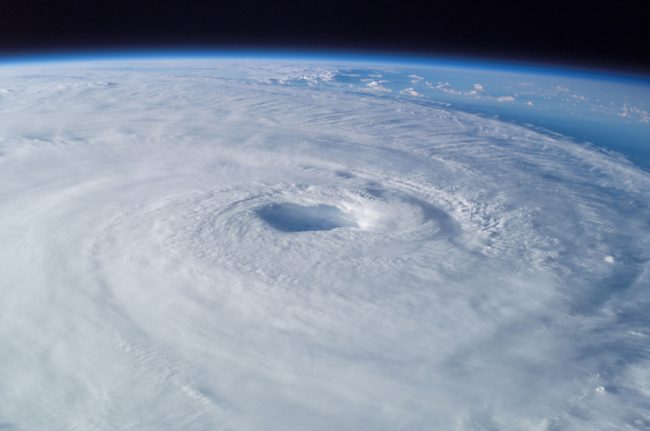You may have heard in the news that a very powerful hurricane named Matthew has reached the state of Florida this morning. Earlier in the week, it hit the Caribbean countries of Haiti, Cuba, Jamaica, and the Bahamas. Though the storm has veered just off shore and has weakened slightly, Matthew is still expected to cause a lot of damage and flooding in the states of Florida, as well as South and North Carolina. Let's look at how these storms form and why they're so dangerous.
As big as they get
This image shows Hurricane Matthew from space as it looked on October 2nd. It was a Category 4 hurricane at the time. The country of Jamaica, Haiti, and Cuba are just to the north of the storm. (Getty Embed)
Hurricanes are the largest storms on earth. They can only form over the open ocean. They are also known as cyclones, when they form in the Indian and South Pacific Oceans, and typhoons, when they form over the northwestern Pacific. But despite the different names, they are the same type of storm (we'll stick to using hurricane, as that is the type of storm happening right now).
A hurricane can be well over 1000 kilometres across (about 600 miles). That's almost as wide as the entire state of Texas. The winds in a hurricane can reach 200 km/h (120 mph) and higher. The storm also brings heavy rainfall. Because hurricanes can vary in size and strength, there is a system to measure them. It goes from Category 1, which is the weakest hurricane, to Category 5, the strongest. Hurricanes don't always stay the same size and strength — Matthew was a Category 4 hurricane when it hit Haiti and Cuba, but it is currently a Category 3 (this is still a very powerful storm, though).
Warm water, rising air
We mentioned that hurricanes form over the ocean. Specifically, they form over very warm water (80°F and above). That warm water is what gives the storm energy — turning it from an average thunderstorm into a tropical storm, and finally, a hurricane. The warm water heats the air above it, making this air rise. Because it rises quickly, the cooler air above must get out of the way. It falls quickly outward away from the centre of the storm. All of this quickly rising and falling air begins to gain speed and force, making the storm grow and spin.
Heed the warnings
A hurricane is extremely dangerous. Its wind can remove a roof from a home or toss cars down the street. And as the storm reaches land (or makes landfall), it brings with it the "storm surge". These are high waters lifted up by the centre of the storm that cause deep flooding. In many cases, this flooding is the most damaging part of the storm. Even if a structure is strong enough to stand up to high winds, water has a way of getting into buildings and destroying valuables, foundations, and cutting off power for days or even weeks.
In the end, we can be glad that modern science at least allows meteorologists (weather scientists) to predict, observe, and track hurricanes. Sure, we can't stop hurricanes from happening — but we can get enough warning to evacuate areas, save precious possessions, and seek shelter. Right now, citizens across the coast of the southeastern United States are safer because their governments and rescue services are ready. Matthew will damage homes and property. But as the saying goes, these things can be rebuilt — what matters more are that people's lives are saved thanks to our ability to understand how and where hurricanes form.
 A hurricane is one of the most powerful storms on earth. (© Xneo | Dreamstime.com)
A hurricane is one of the most powerful storms on earth. (© Xneo | Dreamstime.com)










After reading this article, the members of my class had some thoughts that they were thinking.
Brendan and Dakota are thinking that Hurrican Matthew sounds very dangerous. A hurricane is dangerous because it can hurt people and it can destroy property. Bradley is now aware of how very dangerous the hurricanes are. He was shocked by how damaging the hurricane was in smaller countries in the Carribean. Austin learned that Hurricanes were formed from warm waters. This surprised him. Savion now knows that hurricanes can be very devastating to people as they have to have money in order to rebuild what the storm damaged.
We are thinking that Global Warming has strengthened the categories of many storms. With Global Warming, the higher air temperatures will make warmer waters that will feed the storms and make them more dangerous.
It is essential that we understand that hurricanes are increasing due to global warming, climate change. It is vital that human beings take strong action to reduce our impact on the climate.
wow its very dangerris once i was come home and on the radio car the music stops
and says there might me a tornado and was panicing then whe i got home i saw
the wether channel and talked about the tornado and when a guy stoll a kid
but it was accaly the kids father